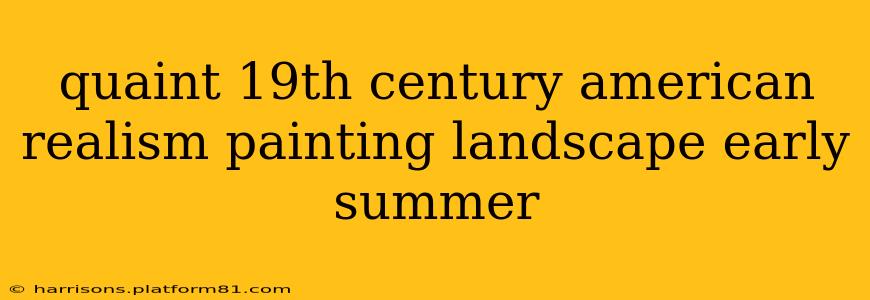The 19th century witnessed a blossoming of American art, moving away from European styles and embracing its own unique identity. American Realism, in particular, captured the essence of the nation's landscapes and everyday life with a stark honesty and meticulous detail. Within this movement, paintings depicting the early summer landscape hold a special charm, showcasing the vibrant hues and tranquil scenes of a burgeoning season. These works often evoke a sense of nostalgia and peaceful contemplation, transporting the viewer to a simpler time.
What defined 19th-century American Realism landscape painting?
American Realism in landscape painting differed from the Romantic ideals prevalent in Europe. Instead of focusing on idealized, dramatic scenes, Realist artists prioritized accurate depictions of the natural world. This meant meticulously rendering the textures of foliage, the subtle variations in light, and the overall atmosphere of a particular place and time. Artists often worked en plein air—painting outdoors—to capture the fleeting effects of light and shadow more accurately. The focus shifted from grand, sweeping vistas to more intimate, focused scenes, often featuring everyday elements of rural or urban life subtly integrated into the landscape.
What are some characteristics of an early summer landscape in this style?
Early summer landscapes from this period typically showcased the burgeoning life of the season. Expect to see:
- Lush Greenery: The paintings often featured vibrant greens of newly-leafed trees and bushes, contrasting with the softer greens of meadows and fields.
- Detailed Foliage: Individual leaves and branches are often meticulously rendered, emphasizing the texture and density of the vegetation.
- Soft Light: The light is typically softer and less harsh than in the height of summer, casting gentle shadows and illuminating details with a warm glow.
- Floral Elements: Wildflowers or cultivated blooms might appear, adding splashes of color and texture to the overall composition.
- Signs of Human Activity (Subtle): A small farmhouse in the distance, a winding path, or a lone figure working in a field might subtly suggest human presence without dominating the scene. These elements are typically incorporated to provide scale and context.
What artists are known for this style of painting?
While many artists contributed to the movement, some key figures whose works often featured early summer landscapes within the American Realism tradition include:
- George Inness: Known for his evocative landscapes that captured the mood and atmosphere of nature, often with a touch of romanticism blended into his realism.
- Thomas Cole: A founder of the Hudson River School, though technically pre-Realism, Cole's detailed landscapes laid the groundwork for many Realist painters.
- Albert Bierstadt: Famous for his dramatic, large-scale landscapes of the American West, Bierstadt's work, while sometimes leaning towards Romanticism, also displayed a dedication to detailed rendering of the natural world. Even within his grand panoramas, close examination often reveals meticulous detail in the vegetation.
How can I identify a genuine 19th-century American Realism landscape?
Authenticating a painting as a genuine 19th-century American Realism work requires expertise. Look for:
- Brushwork: Examine the brushstrokes for evidence of meticulous detail and a realistic approach to rendering textures and forms.
- Palette: The color palette should reflect the natural hues of the early summer landscape.
- Subject Matter: The scene should depict a recognizable American landscape with details consistent with the time period.
- Provenance: A documented history of ownership and exhibition can greatly assist in verifying authenticity. This requires expert appraisal.
Are there any museums or galleries that showcase these paintings?
Many museums across the United States hold significant collections of 19th-century American Realism paintings. These include:
- The Metropolitan Museum of Art (New York City): Houses a vast collection of American art, including many landscape paintings from this period.
- The National Gallery of Art (Washington, D.C.): Features a strong collection of American art, with a dedicated section for 19th-century works.
- The Museum of Fine Arts (Boston): Also possesses a substantial collection of American landscape paintings.
Exploring these collections and others will provide an excellent opportunity to appreciate the beauty and detail of these quaint early summer landscapes from 19th-century American Realism. Remember to consult reputable museum websites and scholarly resources for further information.
